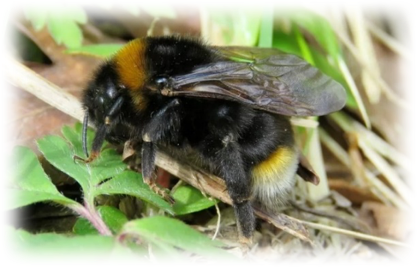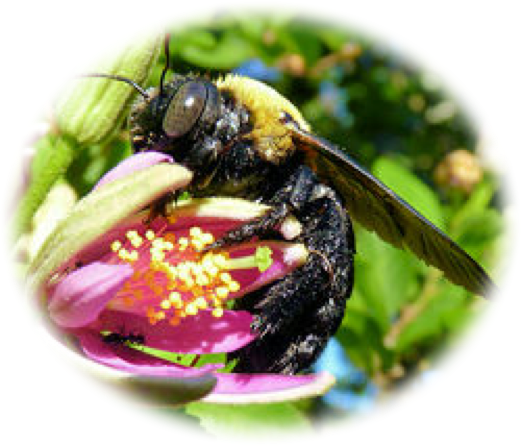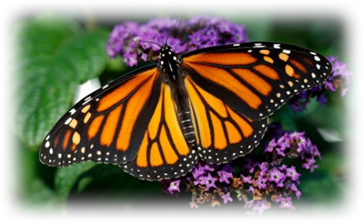Pollinators enhance the success of plant products, with honeybees being the most commonly used in agriculture. Honeybees live in large populations and cover a range of territory, such as fields of corn, pumpkins and watermelons. Honeybees are important to many crops, and they produce honey that humans use as a food source. In addition to honeybees, several other species of pollinators also benefit agriculture. It is necessary to recognize these species and maintain an awareness of their habits and food sources, so that one can provide them with a stable environment.
Why use Alternative Pollinators?
While honeybees are beneficial to many crops, it is always in the best interest of farmers and gardeners to promote multiple species and avoid a monoculture for the sake of diversity. Alternative pollinators have characteristics that increase their beneficial function in situations that are ill-suited for honeybees. Larger bees transport greater quantities of pollen, and are able to reach the pollen and nectar of deeper flowers such as Hibiscus. Particular species of bees are tolerant to weather changes, including cold weather, while some can handle the heat of a greenhouse, making them excellent choices for nursery pollination. Bumblebees and Carpenter Bees are docile toward humans because they reside away from human reach, either underground or in holes made in tree bark. These species are highly successful in urban areas such as home gardens.

Alternative Pollinator Species
Bumblebees frequent fields, gardens and farms. Bumblebees (unlike the similar Carpenter Bees) are fuzzy, with yellow and white stripes. Bombus impatiens (Common Eastern Bumblebee) is the primary species used for commercial pollination of farms in North America. This species pollinates many of the same flowers that honeybees visit, including watermelons and cucumbers. Beehives are produced for bumblebees so that farmers can create a population used for their crops. While the Common Eastern Bumblebee is the typical commercially purchased species, there are many others in the wild that are relied upon to visit a wider variety of crops. Bumblebees are known to visit and pollinate berries (such as blueberries and strawberries), tomatoes, alfalfa, sweet peppers and sunflowers. Bumblebees also employ buzz pollination, whereby they vibrate while seeking nectar and pollen from plants which only release their pollen when shaken. This allows Bumblebees to access species of plants such as the Tomato family, that may be inaccessible to other bees.
Mason Bees are solitary bees which use mud to form nests. They are also immune to the common pest of Honeybees, varroa mites. Due to their status as solitary bees, they are less likely to sting when handled, unlike Honeybees. Mason Bees are used as pollinators of fruits and nuts, which is necessary since fruits and nuts gain increased flavor from pollination. With Honeybees, Bumblebees and Mason Bees all pollinating fruits, a greater flavor is guaranteed, an additional benefit of including multiple bee species in agricultural pollination. Mason Bees can be housed using wooden hives, which keeps them available for crop pollination. Mason Bees, like Bumblebees, seek out pollen to use for their nests. Mason Bees are an excellent option for blueberry producers.
Carpenter Bees are solitary and create their homes by drilling holes in wood, including tree bark and wood structures around buildings. Carpenter Bees are shiny black with a yellow thorax, and are typically non aggressive. They prefer plants with bell shaped flowers in purple and yellow shades. These bees employ buzz pollination to loosen pollen from flowers, and pollinate a wide range of plants including cucumbers, pumpkins, squash, watermelons and sweet potato. These bees are known to chew holes in the sides of flowers to steal nectar, which allows other pollinators to rob the flower through the opening. Commercial carpenter bee nests are made of wood with a single hole, and can be used to convince them to remain on the farm or garden.


Monarch Butterflies are one of the most common pollinators in the United States. They drink nectar from any source they can find, but prefer Milkweed above other plants. A large swarm of Monarch Butterflies appears in Texas during the fall, to feed and move south for the winter season. Because of this, they require a large source of food. Monarch Butterflies pollinate many plants such as corn, alfalfa, most fruits, and native flowers such as Coneflower. Monarch Butterflies need almost no maintenance to keep a population active in the garden or farm. Their primary needs include plentiful Milkweed for their larvae, and a water source. They are free of diseases, tolerate cooler weather, and do not need a supplement for nectar during the fall.
Resources
- Mader; Spivak; Evans. Managing Alternative Pollinators. SARE Handbook 11. 2014.
- Potter, Michael. University of Kentucky College of Agriculture. Carpenter Bees. 2018.
- National Geographic. Monarch Butterfly. https://www.nationalgeographic.com/animals/invertebrates/m/monarch-butterfly/
